Organizational Behavior: Team Performance and Motivation Report
VerifiedAdded on 2021/01/02
|10
|2775
|135
Report
AI Summary
This report provides a detailed analysis of organizational behavior, focusing on team dynamics, leadership, and motivational theories within the context of Tesco. It begins by differentiating between effective and ineffective teams, examining various team types within Tesco and applying Tuckman's team development theory. The report then delves into the concepts and philosophies of organizational behavior, specifically exploring the Path Goal theory and its application in Tesco's leadership approach. Furthermore, it investigates how organizational culture, politics, and power influence individual and team behavior and performance, referencing Handy's cultural typology and French and Raven's model of power. Finally, the report examines various motivational theories, including Maslow's hierarchy of needs and expectancy theory, to understand how to influence employee behavior and improve performance within the workplace. The report highlights how Tesco utilizes these theories and concepts to foster a positive and productive work environment.
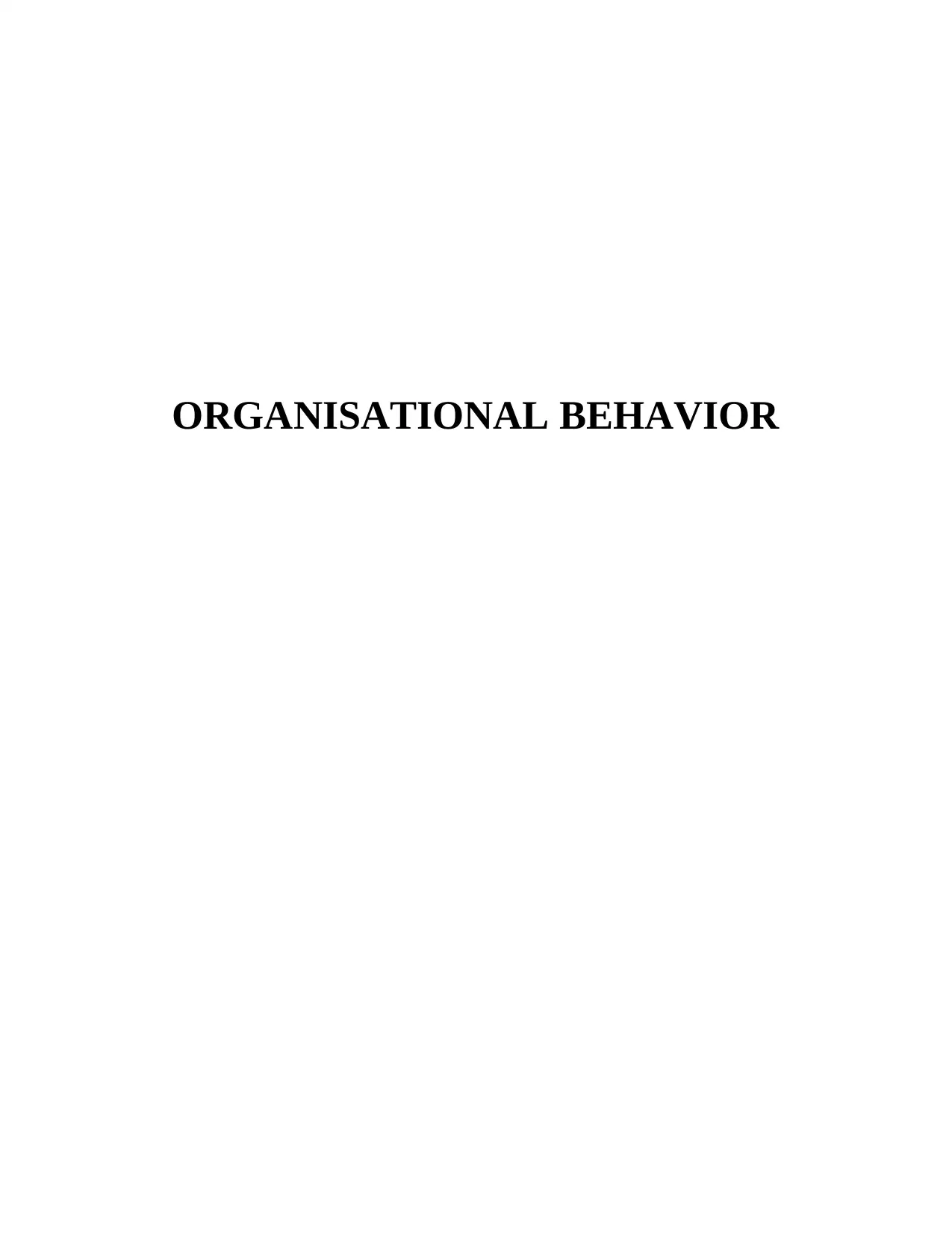
ORGANISATIONAL BEHAVIOR
Paraphrase This Document
Need a fresh take? Get an instant paraphrase of this document with our AI Paraphraser
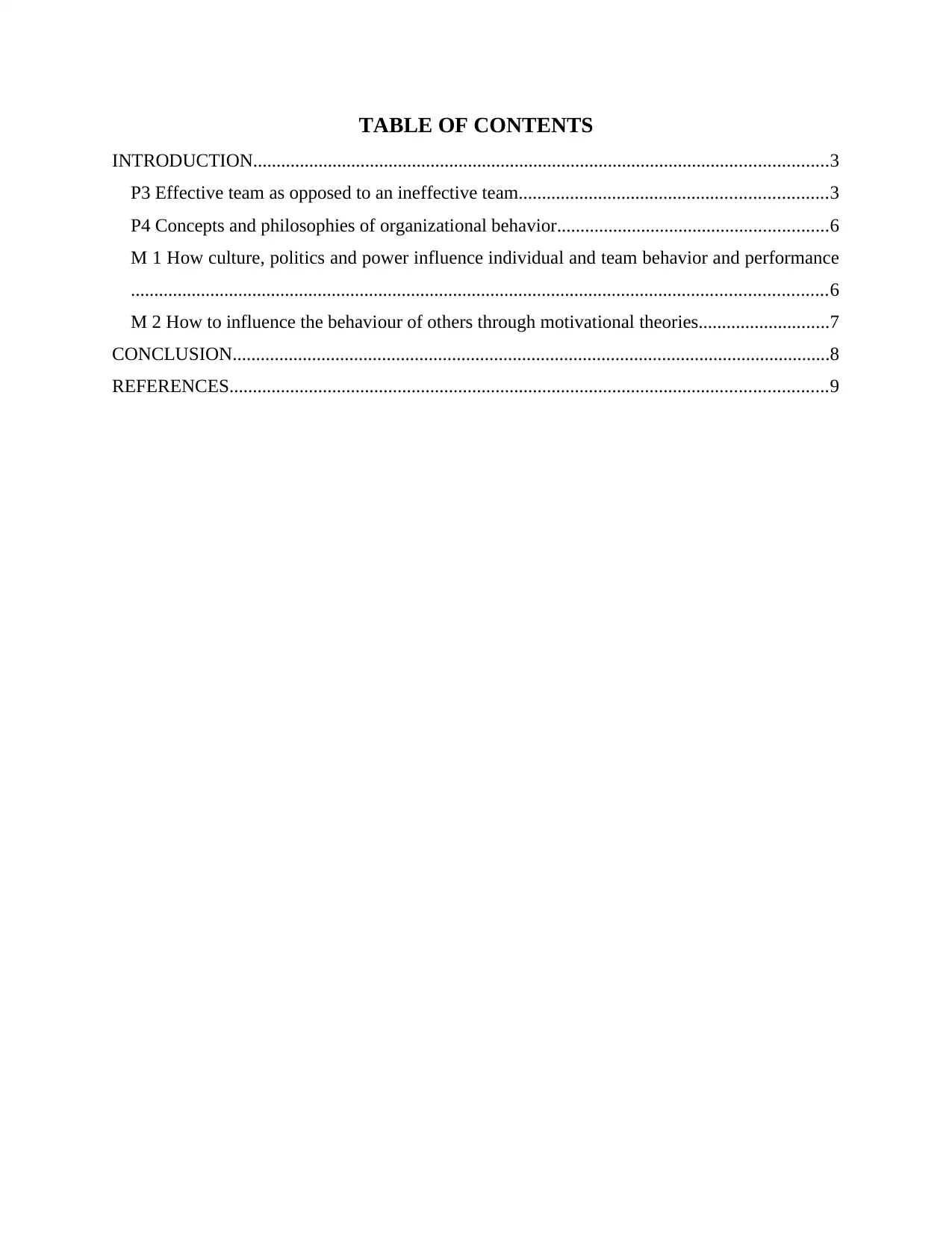
TABLE OF CONTENTS
INTRODUCTION...........................................................................................................................3
P3 Effective team as opposed to an ineffective team..................................................................3
P4 Concepts and philosophies of organizational behavior..........................................................6
M 1 How culture, politics and power influence individual and team behavior and performance
.....................................................................................................................................................6
M 2 How to influence the behaviour of others through motivational theories............................7
CONCLUSION................................................................................................................................8
REFERENCES................................................................................................................................9
INTRODUCTION...........................................................................................................................3
P3 Effective team as opposed to an ineffective team..................................................................3
P4 Concepts and philosophies of organizational behavior..........................................................6
M 1 How culture, politics and power influence individual and team behavior and performance
.....................................................................................................................................................6
M 2 How to influence the behaviour of others through motivational theories............................7
CONCLUSION................................................................................................................................8
REFERENCES................................................................................................................................9
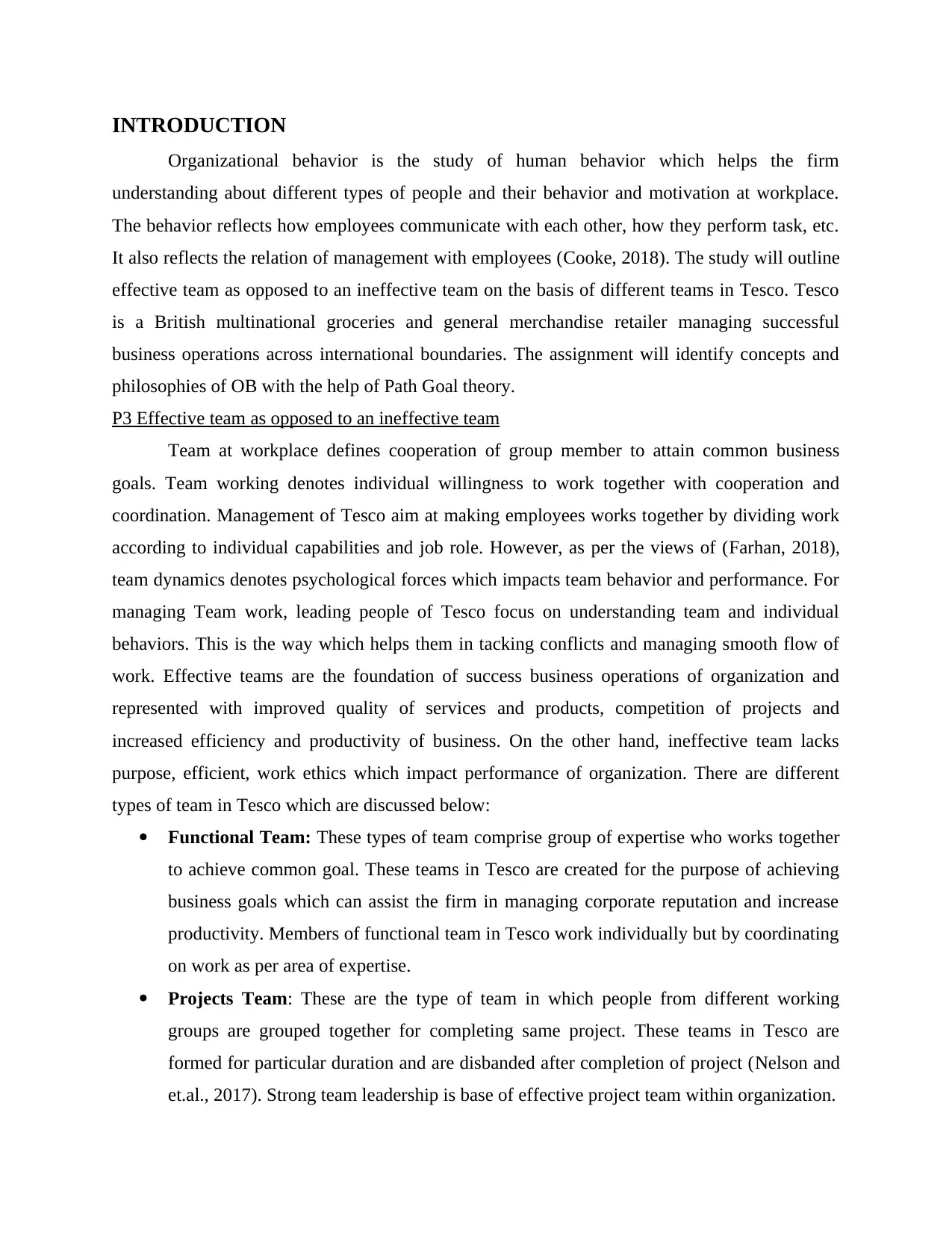
INTRODUCTION
Organizational behavior is the study of human behavior which helps the firm
understanding about different types of people and their behavior and motivation at workplace.
The behavior reflects how employees communicate with each other, how they perform task, etc.
It also reflects the relation of management with employees (Cooke, 2018). The study will outline
effective team as opposed to an ineffective team on the basis of different teams in Tesco. Tesco
is a British multinational groceries and general merchandise retailer managing successful
business operations across international boundaries. The assignment will identify concepts and
philosophies of OB with the help of Path Goal theory.
P3 Effective team as opposed to an ineffective team
Team at workplace defines cooperation of group member to attain common business
goals. Team working denotes individual willingness to work together with cooperation and
coordination. Management of Tesco aim at making employees works together by dividing work
according to individual capabilities and job role. However, as per the views of (Farhan, 2018),
team dynamics denotes psychological forces which impacts team behavior and performance. For
managing Team work, leading people of Tesco focus on understanding team and individual
behaviors. This is the way which helps them in tacking conflicts and managing smooth flow of
work. Effective teams are the foundation of success business operations of organization and
represented with improved quality of services and products, competition of projects and
increased efficiency and productivity of business. On the other hand, ineffective team lacks
purpose, efficient, work ethics which impact performance of organization. There are different
types of team in Tesco which are discussed below:
Functional Team: These types of team comprise group of expertise who works together
to achieve common goal. These teams in Tesco are created for the purpose of achieving
business goals which can assist the firm in managing corporate reputation and increase
productivity. Members of functional team in Tesco work individually but by coordinating
on work as per area of expertise.
Projects Team: These are the type of team in which people from different working
groups are grouped together for completing same project. These teams in Tesco are
formed for particular duration and are disbanded after completion of project (Nelson and
et.al., 2017). Strong team leadership is base of effective project team within organization.
Organizational behavior is the study of human behavior which helps the firm
understanding about different types of people and their behavior and motivation at workplace.
The behavior reflects how employees communicate with each other, how they perform task, etc.
It also reflects the relation of management with employees (Cooke, 2018). The study will outline
effective team as opposed to an ineffective team on the basis of different teams in Tesco. Tesco
is a British multinational groceries and general merchandise retailer managing successful
business operations across international boundaries. The assignment will identify concepts and
philosophies of OB with the help of Path Goal theory.
P3 Effective team as opposed to an ineffective team
Team at workplace defines cooperation of group member to attain common business
goals. Team working denotes individual willingness to work together with cooperation and
coordination. Management of Tesco aim at making employees works together by dividing work
according to individual capabilities and job role. However, as per the views of (Farhan, 2018),
team dynamics denotes psychological forces which impacts team behavior and performance. For
managing Team work, leading people of Tesco focus on understanding team and individual
behaviors. This is the way which helps them in tacking conflicts and managing smooth flow of
work. Effective teams are the foundation of success business operations of organization and
represented with improved quality of services and products, competition of projects and
increased efficiency and productivity of business. On the other hand, ineffective team lacks
purpose, efficient, work ethics which impact performance of organization. There are different
types of team in Tesco which are discussed below:
Functional Team: These types of team comprise group of expertise who works together
to achieve common goal. These teams in Tesco are created for the purpose of achieving
business goals which can assist the firm in managing corporate reputation and increase
productivity. Members of functional team in Tesco work individually but by coordinating
on work as per area of expertise.
Projects Team: These are the type of team in which people from different working
groups are grouped together for completing same project. These teams in Tesco are
formed for particular duration and are disbanded after completion of project (Nelson and
et.al., 2017). Strong team leadership is base of effective project team within organization.
⊘ This is a preview!⊘
Do you want full access?
Subscribe today to unlock all pages.

Trusted by 1+ million students worldwide
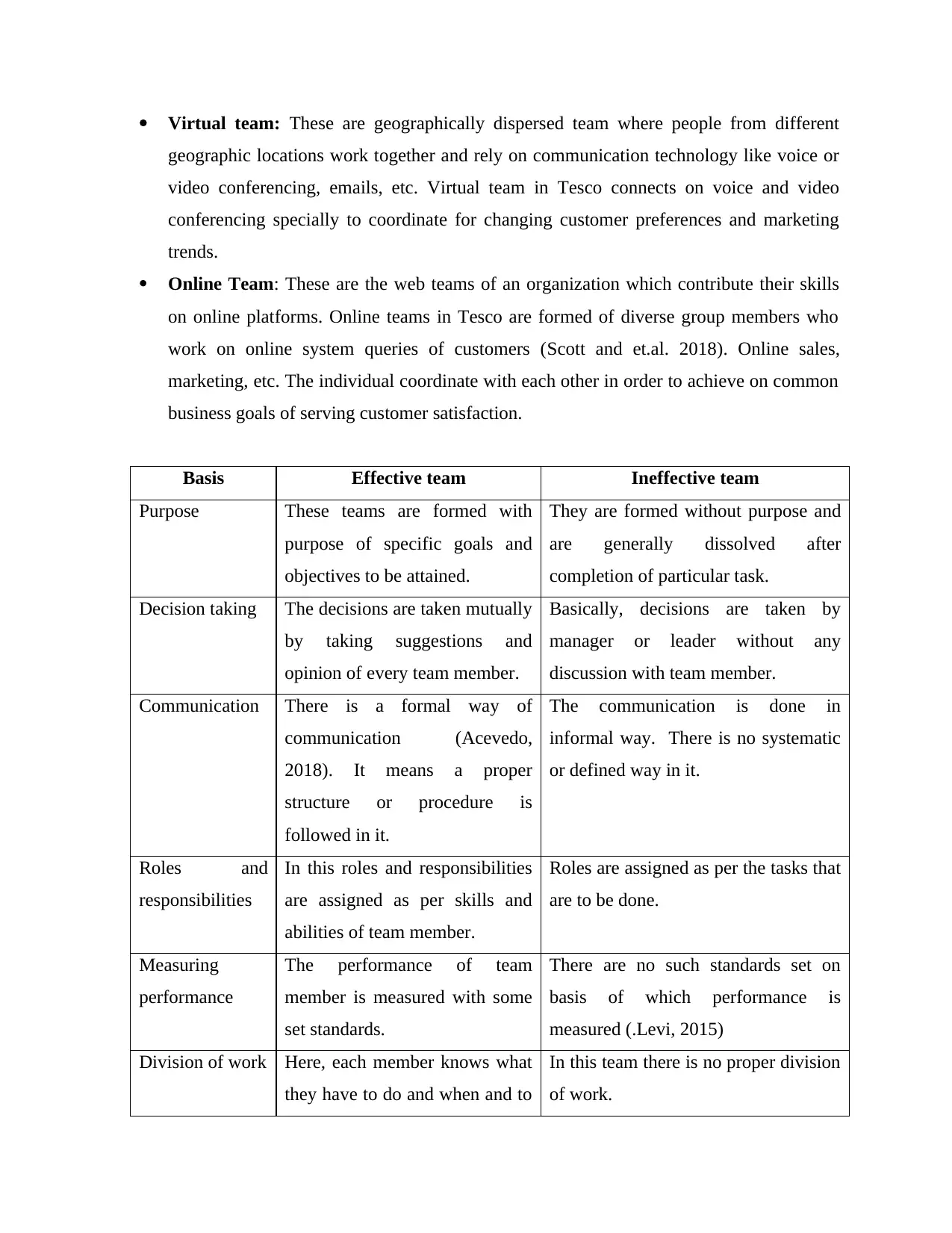
Virtual team: These are geographically dispersed team where people from different
geographic locations work together and rely on communication technology like voice or
video conferencing, emails, etc. Virtual team in Tesco connects on voice and video
conferencing specially to coordinate for changing customer preferences and marketing
trends.
Online Team: These are the web teams of an organization which contribute their skills
on online platforms. Online teams in Tesco are formed of diverse group members who
work on online system queries of customers (Scott and et.al. 2018). Online sales,
marketing, etc. The individual coordinate with each other in order to achieve on common
business goals of serving customer satisfaction.
Basis Effective team Ineffective team
Purpose These teams are formed with
purpose of specific goals and
objectives to be attained.
They are formed without purpose and
are generally dissolved after
completion of particular task.
Decision taking The decisions are taken mutually
by taking suggestions and
opinion of every team member.
Basically, decisions are taken by
manager or leader without any
discussion with team member.
Communication There is a formal way of
communication (Acevedo,
2018). It means a proper
structure or procedure is
followed in it.
The communication is done in
informal way. There is no systematic
or defined way in it.
Roles and
responsibilities
In this roles and responsibilities
are assigned as per skills and
abilities of team member.
Roles are assigned as per the tasks that
are to be done.
Measuring
performance
The performance of team
member is measured with some
set standards.
There are no such standards set on
basis of which performance is
measured (.Levi, 2015)
Division of work Here, each member knows what
they have to do and when and to
In this team there is no proper division
of work.
geographic locations work together and rely on communication technology like voice or
video conferencing, emails, etc. Virtual team in Tesco connects on voice and video
conferencing specially to coordinate for changing customer preferences and marketing
trends.
Online Team: These are the web teams of an organization which contribute their skills
on online platforms. Online teams in Tesco are formed of diverse group members who
work on online system queries of customers (Scott and et.al. 2018). Online sales,
marketing, etc. The individual coordinate with each other in order to achieve on common
business goals of serving customer satisfaction.
Basis Effective team Ineffective team
Purpose These teams are formed with
purpose of specific goals and
objectives to be attained.
They are formed without purpose and
are generally dissolved after
completion of particular task.
Decision taking The decisions are taken mutually
by taking suggestions and
opinion of every team member.
Basically, decisions are taken by
manager or leader without any
discussion with team member.
Communication There is a formal way of
communication (Acevedo,
2018). It means a proper
structure or procedure is
followed in it.
The communication is done in
informal way. There is no systematic
or defined way in it.
Roles and
responsibilities
In this roles and responsibilities
are assigned as per skills and
abilities of team member.
Roles are assigned as per the tasks that
are to be done.
Measuring
performance
The performance of team
member is measured with some
set standards.
There are no such standards set on
basis of which performance is
measured (.Levi, 2015)
Division of work Here, each member knows what
they have to do and when and to
In this team there is no proper division
of work.
Paraphrase This Document
Need a fresh take? Get an instant paraphrase of this document with our AI Paraphraser
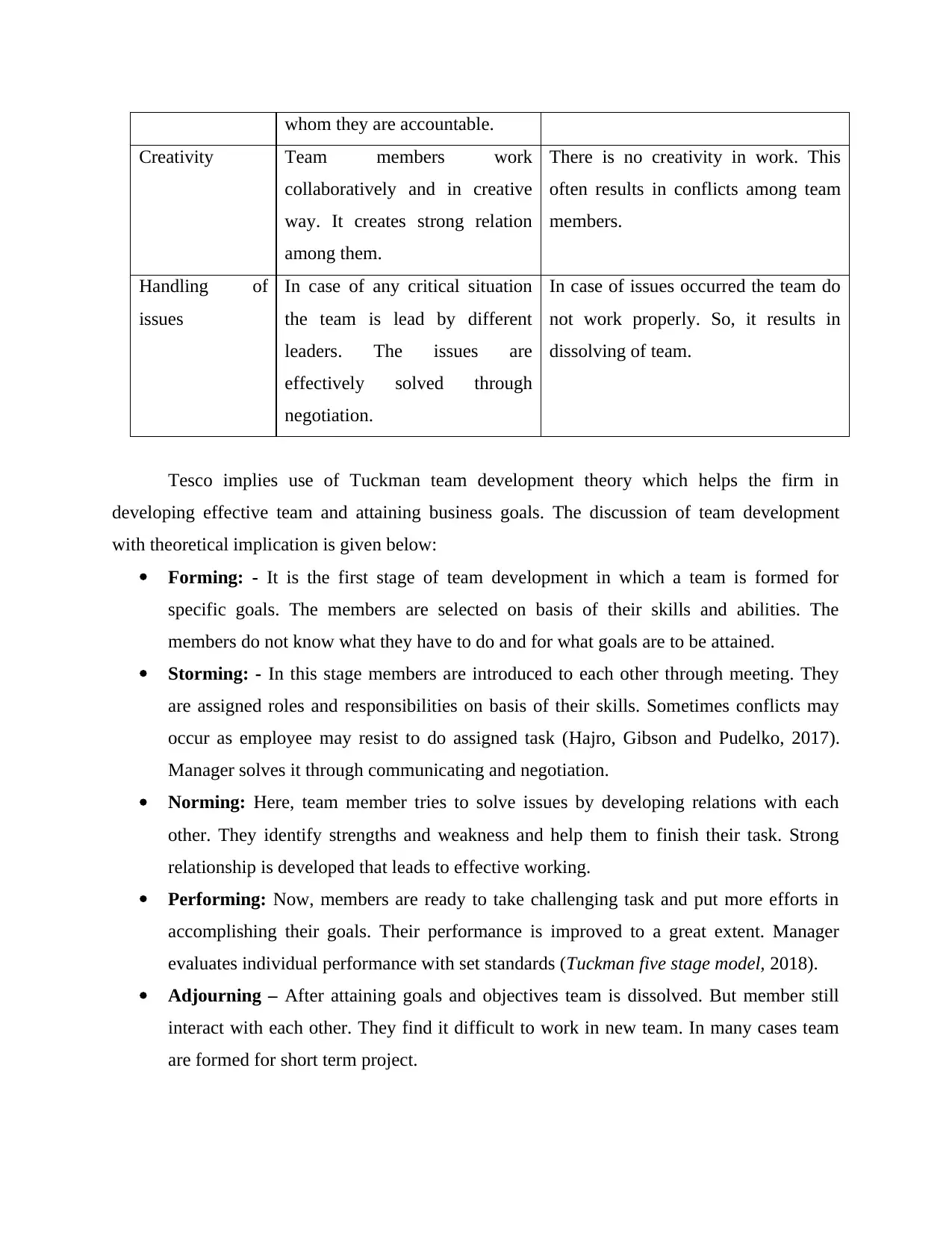
whom they are accountable.
Creativity Team members work
collaboratively and in creative
way. It creates strong relation
among them.
There is no creativity in work. This
often results in conflicts among team
members.
Handling of
issues
In case of any critical situation
the team is lead by different
leaders. The issues are
effectively solved through
negotiation.
In case of issues occurred the team do
not work properly. So, it results in
dissolving of team.
Tesco implies use of Tuckman team development theory which helps the firm in
developing effective team and attaining business goals. The discussion of team development
with theoretical implication is given below:
Forming: - It is the first stage of team development in which a team is formed for
specific goals. The members are selected on basis of their skills and abilities. The
members do not know what they have to do and for what goals are to be attained.
Storming: - In this stage members are introduced to each other through meeting. They
are assigned roles and responsibilities on basis of their skills. Sometimes conflicts may
occur as employee may resist to do assigned task (Hajro, Gibson and Pudelko, 2017).
Manager solves it through communicating and negotiation.
Norming: Here, team member tries to solve issues by developing relations with each
other. They identify strengths and weakness and help them to finish their task. Strong
relationship is developed that leads to effective working.
Performing: Now, members are ready to take challenging task and put more efforts in
accomplishing their goals. Their performance is improved to a great extent. Manager
evaluates individual performance with set standards (Tuckman five stage model, 2018).
Adjourning – After attaining goals and objectives team is dissolved. But member still
interact with each other. They find it difficult to work in new team. In many cases team
are formed for short term project.
Creativity Team members work
collaboratively and in creative
way. It creates strong relation
among them.
There is no creativity in work. This
often results in conflicts among team
members.
Handling of
issues
In case of any critical situation
the team is lead by different
leaders. The issues are
effectively solved through
negotiation.
In case of issues occurred the team do
not work properly. So, it results in
dissolving of team.
Tesco implies use of Tuckman team development theory which helps the firm in
developing effective team and attaining business goals. The discussion of team development
with theoretical implication is given below:
Forming: - It is the first stage of team development in which a team is formed for
specific goals. The members are selected on basis of their skills and abilities. The
members do not know what they have to do and for what goals are to be attained.
Storming: - In this stage members are introduced to each other through meeting. They
are assigned roles and responsibilities on basis of their skills. Sometimes conflicts may
occur as employee may resist to do assigned task (Hajro, Gibson and Pudelko, 2017).
Manager solves it through communicating and negotiation.
Norming: Here, team member tries to solve issues by developing relations with each
other. They identify strengths and weakness and help them to finish their task. Strong
relationship is developed that leads to effective working.
Performing: Now, members are ready to take challenging task and put more efforts in
accomplishing their goals. Their performance is improved to a great extent. Manager
evaluates individual performance with set standards (Tuckman five stage model, 2018).
Adjourning – After attaining goals and objectives team is dissolved. But member still
interact with each other. They find it difficult to work in new team. In many cases team
are formed for short term project.
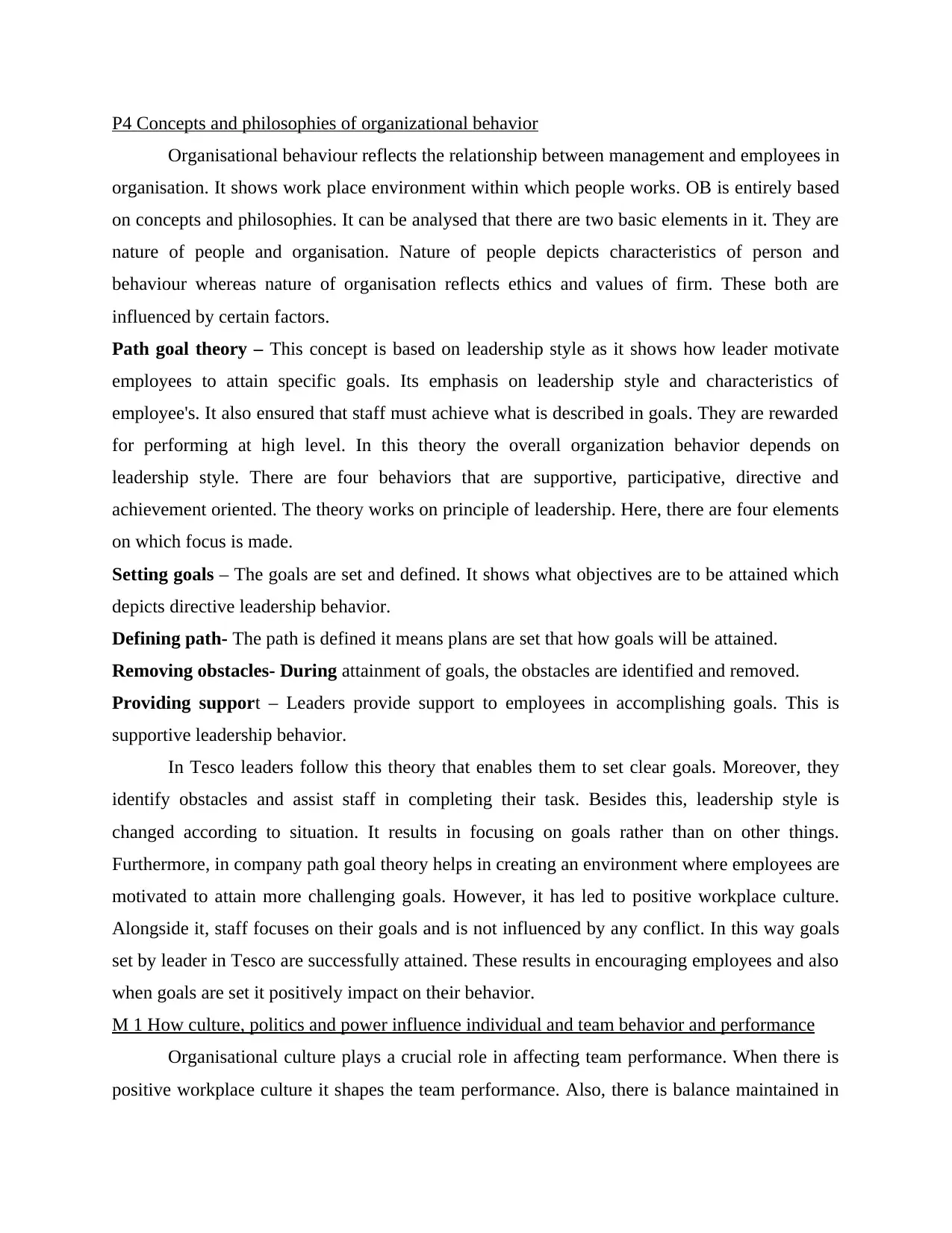
P4 Concepts and philosophies of organizational behavior
Organisational behaviour reflects the relationship between management and employees in
organisation. It shows work place environment within which people works. OB is entirely based
on concepts and philosophies. It can be analysed that there are two basic elements in it. They are
nature of people and organisation. Nature of people depicts characteristics of person and
behaviour whereas nature of organisation reflects ethics and values of firm. These both are
influenced by certain factors.
Path goal theory – This concept is based on leadership style as it shows how leader motivate
employees to attain specific goals. Its emphasis on leadership style and characteristics of
employee's. It also ensured that staff must achieve what is described in goals. They are rewarded
for performing at high level. In this theory the overall organization behavior depends on
leadership style. There are four behaviors that are supportive, participative, directive and
achievement oriented. The theory works on principle of leadership. Here, there are four elements
on which focus is made.
Setting goals – The goals are set and defined. It shows what objectives are to be attained which
depicts directive leadership behavior.
Defining path- The path is defined it means plans are set that how goals will be attained.
Removing obstacles- During attainment of goals, the obstacles are identified and removed.
Providing support – Leaders provide support to employees in accomplishing goals. This is
supportive leadership behavior.
In Tesco leaders follow this theory that enables them to set clear goals. Moreover, they
identify obstacles and assist staff in completing their task. Besides this, leadership style is
changed according to situation. It results in focusing on goals rather than on other things.
Furthermore, in company path goal theory helps in creating an environment where employees are
motivated to attain more challenging goals. However, it has led to positive workplace culture.
Alongside it, staff focuses on their goals and is not influenced by any conflict. In this way goals
set by leader in Tesco are successfully attained. These results in encouraging employees and also
when goals are set it positively impact on their behavior.
M 1 How culture, politics and power influence individual and team behavior and performance
Organisational culture plays a crucial role in affecting team performance. When there is
positive workplace culture it shapes the team performance. Also, there is balance maintained in
Organisational behaviour reflects the relationship between management and employees in
organisation. It shows work place environment within which people works. OB is entirely based
on concepts and philosophies. It can be analysed that there are two basic elements in it. They are
nature of people and organisation. Nature of people depicts characteristics of person and
behaviour whereas nature of organisation reflects ethics and values of firm. These both are
influenced by certain factors.
Path goal theory – This concept is based on leadership style as it shows how leader motivate
employees to attain specific goals. Its emphasis on leadership style and characteristics of
employee's. It also ensured that staff must achieve what is described in goals. They are rewarded
for performing at high level. In this theory the overall organization behavior depends on
leadership style. There are four behaviors that are supportive, participative, directive and
achievement oriented. The theory works on principle of leadership. Here, there are four elements
on which focus is made.
Setting goals – The goals are set and defined. It shows what objectives are to be attained which
depicts directive leadership behavior.
Defining path- The path is defined it means plans are set that how goals will be attained.
Removing obstacles- During attainment of goals, the obstacles are identified and removed.
Providing support – Leaders provide support to employees in accomplishing goals. This is
supportive leadership behavior.
In Tesco leaders follow this theory that enables them to set clear goals. Moreover, they
identify obstacles and assist staff in completing their task. Besides this, leadership style is
changed according to situation. It results in focusing on goals rather than on other things.
Furthermore, in company path goal theory helps in creating an environment where employees are
motivated to attain more challenging goals. However, it has led to positive workplace culture.
Alongside it, staff focuses on their goals and is not influenced by any conflict. In this way goals
set by leader in Tesco are successfully attained. These results in encouraging employees and also
when goals are set it positively impact on their behavior.
M 1 How culture, politics and power influence individual and team behavior and performance
Organisational culture plays a crucial role in affecting team performance. When there is
positive workplace culture it shapes the team performance. Also, there is balance maintained in
⊘ This is a preview!⊘
Do you want full access?
Subscribe today to unlock all pages.

Trusted by 1+ million students worldwide
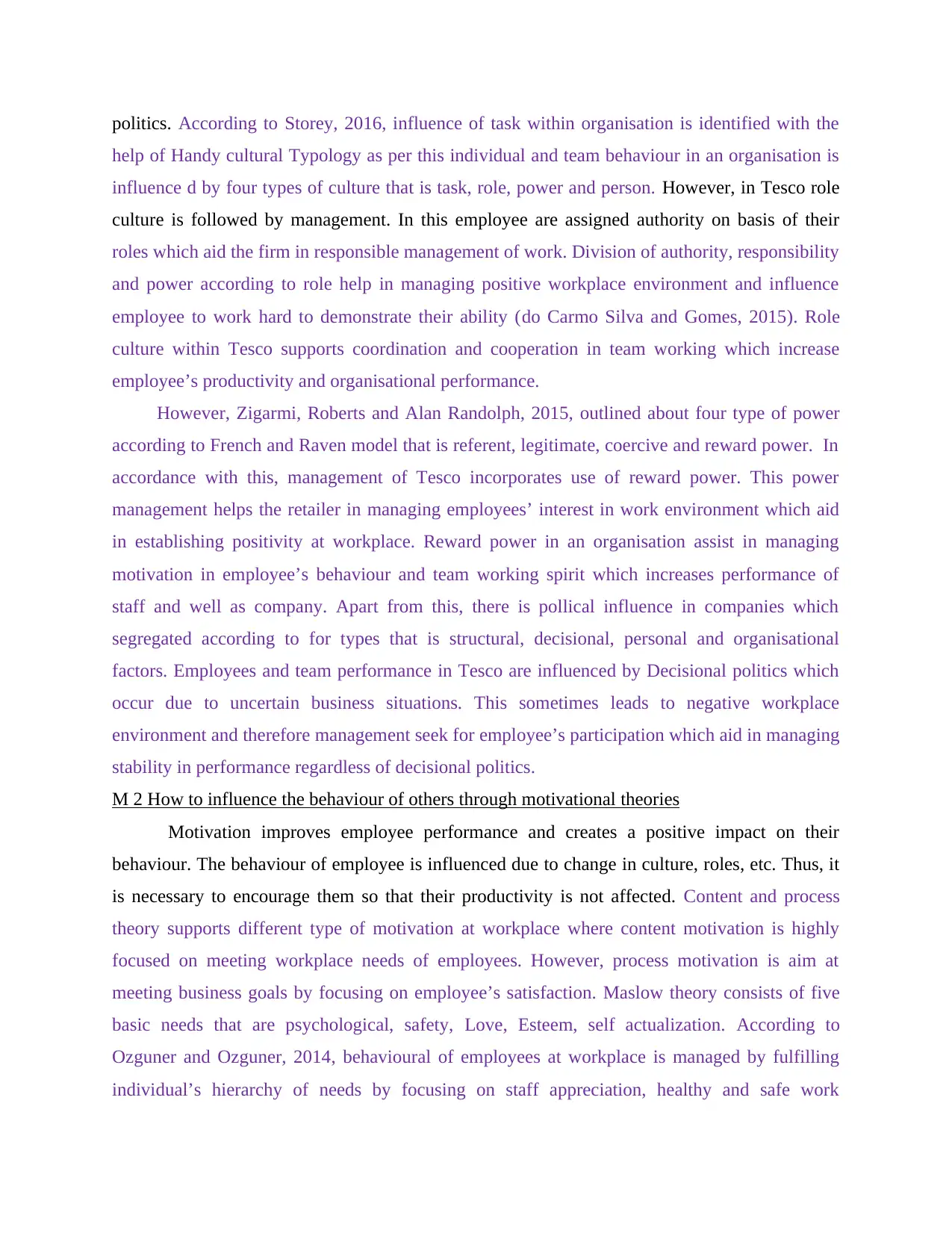
politics. According to Storey, 2016, influence of task within organisation is identified with the
help of Handy cultural Typology as per this individual and team behaviour in an organisation is
influence d by four types of culture that is task, role, power and person. However, in Tesco role
culture is followed by management. In this employee are assigned authority on basis of their
roles which aid the firm in responsible management of work. Division of authority, responsibility
and power according to role help in managing positive workplace environment and influence
employee to work hard to demonstrate their ability (do Carmo Silva and Gomes, 2015). Role
culture within Tesco supports coordination and cooperation in team working which increase
employee’s productivity and organisational performance.
However, Zigarmi, Roberts and Alan Randolph, 2015, outlined about four type of power
according to French and Raven model that is referent, legitimate, coercive and reward power. In
accordance with this, management of Tesco incorporates use of reward power. This power
management helps the retailer in managing employees’ interest in work environment which aid
in establishing positivity at workplace. Reward power in an organisation assist in managing
motivation in employee’s behaviour and team working spirit which increases performance of
staff and well as company. Apart from this, there is pollical influence in companies which
segregated according to for types that is structural, decisional, personal and organisational
factors. Employees and team performance in Tesco are influenced by Decisional politics which
occur due to uncertain business situations. This sometimes leads to negative workplace
environment and therefore management seek for employee’s participation which aid in managing
stability in performance regardless of decisional politics.
M 2 How to influence the behaviour of others through motivational theories
Motivation improves employee performance and creates a positive impact on their
behaviour. The behaviour of employee is influenced due to change in culture, roles, etc. Thus, it
is necessary to encourage them so that their productivity is not affected. Content and process
theory supports different type of motivation at workplace where content motivation is highly
focused on meeting workplace needs of employees. However, process motivation is aim at
meeting business goals by focusing on employee’s satisfaction. Maslow theory consists of five
basic needs that are psychological, safety, Love, Esteem, self actualization. According to
Ozguner and Ozguner, 2014, behavioural of employees at workplace is managed by fulfilling
individual’s hierarchy of needs by focusing on staff appreciation, healthy and safe work
help of Handy cultural Typology as per this individual and team behaviour in an organisation is
influence d by four types of culture that is task, role, power and person. However, in Tesco role
culture is followed by management. In this employee are assigned authority on basis of their
roles which aid the firm in responsible management of work. Division of authority, responsibility
and power according to role help in managing positive workplace environment and influence
employee to work hard to demonstrate their ability (do Carmo Silva and Gomes, 2015). Role
culture within Tesco supports coordination and cooperation in team working which increase
employee’s productivity and organisational performance.
However, Zigarmi, Roberts and Alan Randolph, 2015, outlined about four type of power
according to French and Raven model that is referent, legitimate, coercive and reward power. In
accordance with this, management of Tesco incorporates use of reward power. This power
management helps the retailer in managing employees’ interest in work environment which aid
in establishing positivity at workplace. Reward power in an organisation assist in managing
motivation in employee’s behaviour and team working spirit which increases performance of
staff and well as company. Apart from this, there is pollical influence in companies which
segregated according to for types that is structural, decisional, personal and organisational
factors. Employees and team performance in Tesco are influenced by Decisional politics which
occur due to uncertain business situations. This sometimes leads to negative workplace
environment and therefore management seek for employee’s participation which aid in managing
stability in performance regardless of decisional politics.
M 2 How to influence the behaviour of others through motivational theories
Motivation improves employee performance and creates a positive impact on their
behaviour. The behaviour of employee is influenced due to change in culture, roles, etc. Thus, it
is necessary to encourage them so that their productivity is not affected. Content and process
theory supports different type of motivation at workplace where content motivation is highly
focused on meeting workplace needs of employees. However, process motivation is aim at
meeting business goals by focusing on employee’s satisfaction. Maslow theory consists of five
basic needs that are psychological, safety, Love, Esteem, self actualization. According to
Ozguner and Ozguner, 2014, behavioural of employees at workplace is managed by fulfilling
individual’s hierarchy of needs by focusing on staff appreciation, healthy and safe work
Paraphrase This Document
Need a fresh take? Get an instant paraphrase of this document with our AI Paraphraser
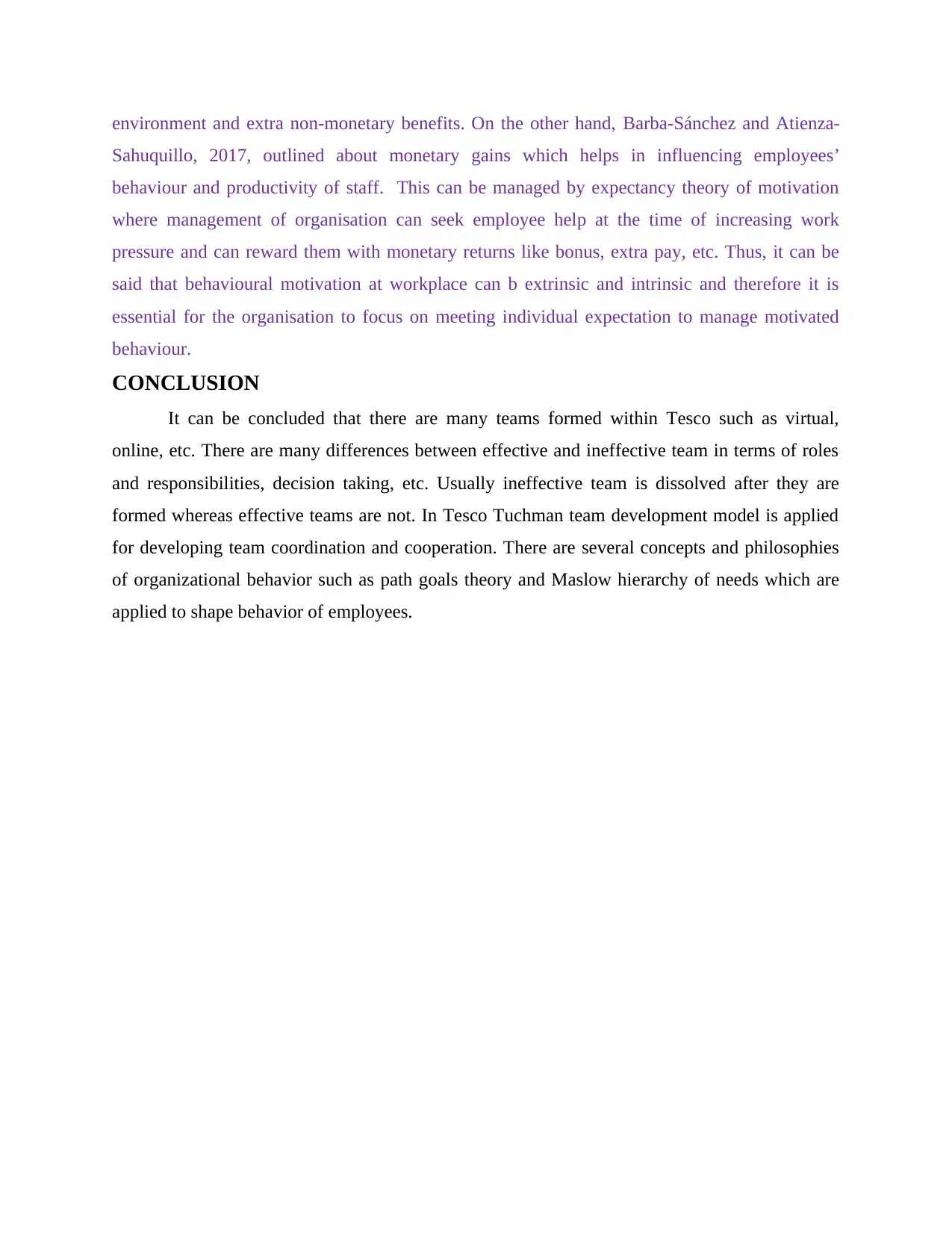
environment and extra non-monetary benefits. On the other hand, Barba-Sánchez and Atienza-
Sahuquillo, 2017, outlined about monetary gains which helps in influencing employees’
behaviour and productivity of staff. This can be managed by expectancy theory of motivation
where management of organisation can seek employee help at the time of increasing work
pressure and can reward them with monetary returns like bonus, extra pay, etc. Thus, it can be
said that behavioural motivation at workplace can b extrinsic and intrinsic and therefore it is
essential for the organisation to focus on meeting individual expectation to manage motivated
behaviour.
CONCLUSION
It can be concluded that there are many teams formed within Tesco such as virtual,
online, etc. There are many differences between effective and ineffective team in terms of roles
and responsibilities, decision taking, etc. Usually ineffective team is dissolved after they are
formed whereas effective teams are not. In Tesco Tuchman team development model is applied
for developing team coordination and cooperation. There are several concepts and philosophies
of organizational behavior such as path goals theory and Maslow hierarchy of needs which are
applied to shape behavior of employees.
Sahuquillo, 2017, outlined about monetary gains which helps in influencing employees’
behaviour and productivity of staff. This can be managed by expectancy theory of motivation
where management of organisation can seek employee help at the time of increasing work
pressure and can reward them with monetary returns like bonus, extra pay, etc. Thus, it can be
said that behavioural motivation at workplace can b extrinsic and intrinsic and therefore it is
essential for the organisation to focus on meeting individual expectation to manage motivated
behaviour.
CONCLUSION
It can be concluded that there are many teams formed within Tesco such as virtual,
online, etc. There are many differences between effective and ineffective team in terms of roles
and responsibilities, decision taking, etc. Usually ineffective team is dissolved after they are
formed whereas effective teams are not. In Tesco Tuchman team development model is applied
for developing team coordination and cooperation. There are several concepts and philosophies
of organizational behavior such as path goals theory and Maslow hierarchy of needs which are
applied to shape behavior of employees.
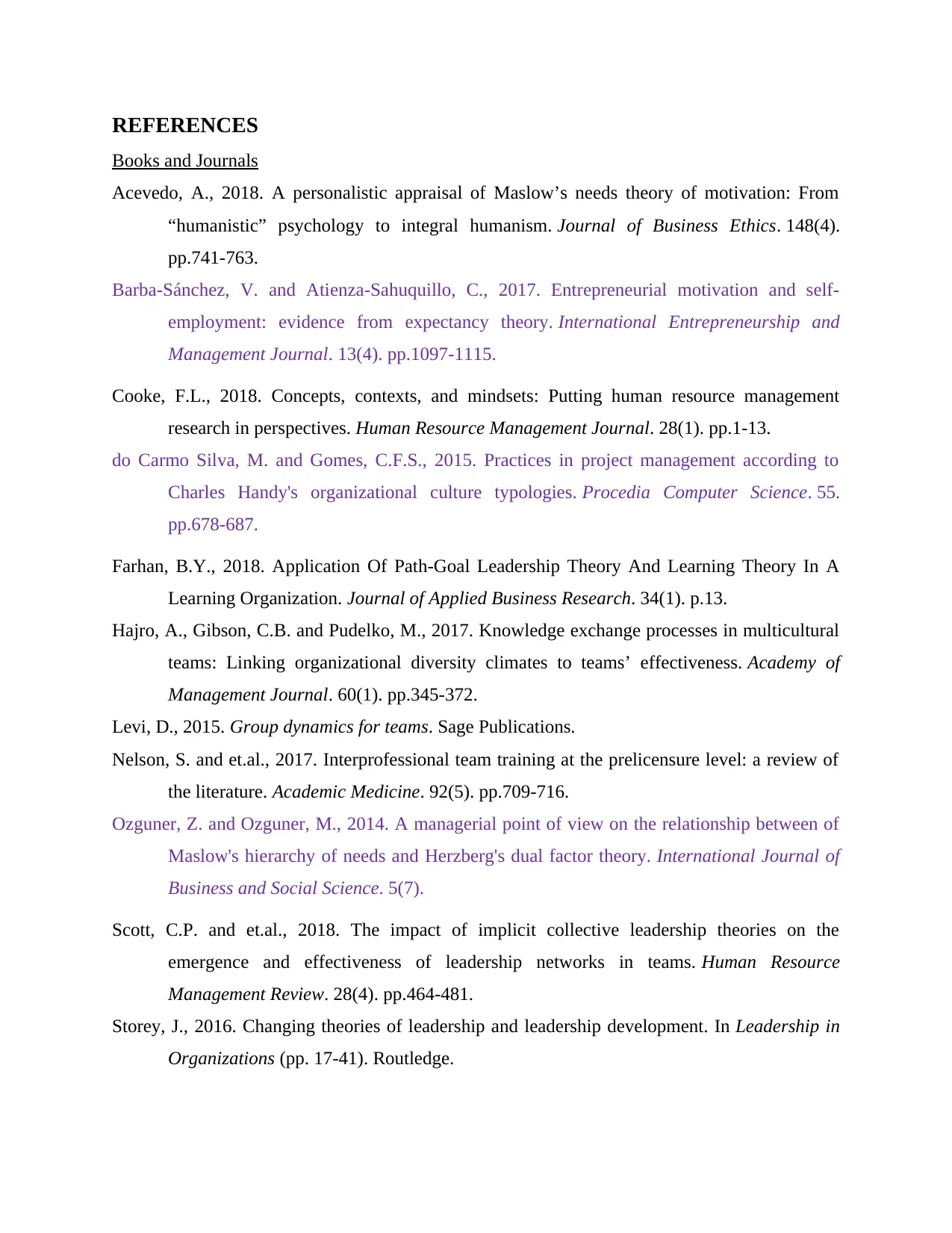
REFERENCES
Books and Journals
Acevedo, A., 2018. A personalistic appraisal of Maslow’s needs theory of motivation: From
“humanistic” psychology to integral humanism. Journal of Business Ethics. 148(4).
pp.741-763.
Barba-Sánchez, V. and Atienza-Sahuquillo, C., 2017. Entrepreneurial motivation and self-
employment: evidence from expectancy theory. International Entrepreneurship and
Management Journal. 13(4). pp.1097-1115.
Cooke, F.L., 2018. Concepts, contexts, and mindsets: Putting human resource management
research in perspectives. Human Resource Management Journal. 28(1). pp.1-13.
do Carmo Silva, M. and Gomes, C.F.S., 2015. Practices in project management according to
Charles Handy's organizational culture typologies. Procedia Computer Science. 55.
pp.678-687.
Farhan, B.Y., 2018. Application Of Path-Goal Leadership Theory And Learning Theory In A
Learning Organization. Journal of Applied Business Research. 34(1). p.13.
Hajro, A., Gibson, C.B. and Pudelko, M., 2017. Knowledge exchange processes in multicultural
teams: Linking organizational diversity climates to teams’ effectiveness. Academy of
Management Journal. 60(1). pp.345-372.
Levi, D., 2015. Group dynamics for teams. Sage Publications.
Nelson, S. and et.al., 2017. Interprofessional team training at the prelicensure level: a review of
the literature. Academic Medicine. 92(5). pp.709-716.
Ozguner, Z. and Ozguner, M., 2014. A managerial point of view on the relationship between of
Maslow's hierarchy of needs and Herzberg's dual factor theory. International Journal of
Business and Social Science. 5(7).
Scott, C.P. and et.al., 2018. The impact of implicit collective leadership theories on the
emergence and effectiveness of leadership networks in teams. Human Resource
Management Review. 28(4). pp.464-481.
Storey, J., 2016. Changing theories of leadership and leadership development. In Leadership in
Organizations (pp. 17-41). Routledge.
Books and Journals
Acevedo, A., 2018. A personalistic appraisal of Maslow’s needs theory of motivation: From
“humanistic” psychology to integral humanism. Journal of Business Ethics. 148(4).
pp.741-763.
Barba-Sánchez, V. and Atienza-Sahuquillo, C., 2017. Entrepreneurial motivation and self-
employment: evidence from expectancy theory. International Entrepreneurship and
Management Journal. 13(4). pp.1097-1115.
Cooke, F.L., 2018. Concepts, contexts, and mindsets: Putting human resource management
research in perspectives. Human Resource Management Journal. 28(1). pp.1-13.
do Carmo Silva, M. and Gomes, C.F.S., 2015. Practices in project management according to
Charles Handy's organizational culture typologies. Procedia Computer Science. 55.
pp.678-687.
Farhan, B.Y., 2018. Application Of Path-Goal Leadership Theory And Learning Theory In A
Learning Organization. Journal of Applied Business Research. 34(1). p.13.
Hajro, A., Gibson, C.B. and Pudelko, M., 2017. Knowledge exchange processes in multicultural
teams: Linking organizational diversity climates to teams’ effectiveness. Academy of
Management Journal. 60(1). pp.345-372.
Levi, D., 2015. Group dynamics for teams. Sage Publications.
Nelson, S. and et.al., 2017. Interprofessional team training at the prelicensure level: a review of
the literature. Academic Medicine. 92(5). pp.709-716.
Ozguner, Z. and Ozguner, M., 2014. A managerial point of view on the relationship between of
Maslow's hierarchy of needs and Herzberg's dual factor theory. International Journal of
Business and Social Science. 5(7).
Scott, C.P. and et.al., 2018. The impact of implicit collective leadership theories on the
emergence and effectiveness of leadership networks in teams. Human Resource
Management Review. 28(4). pp.464-481.
Storey, J., 2016. Changing theories of leadership and leadership development. In Leadership in
Organizations (pp. 17-41). Routledge.
⊘ This is a preview!⊘
Do you want full access?
Subscribe today to unlock all pages.

Trusted by 1+ million students worldwide
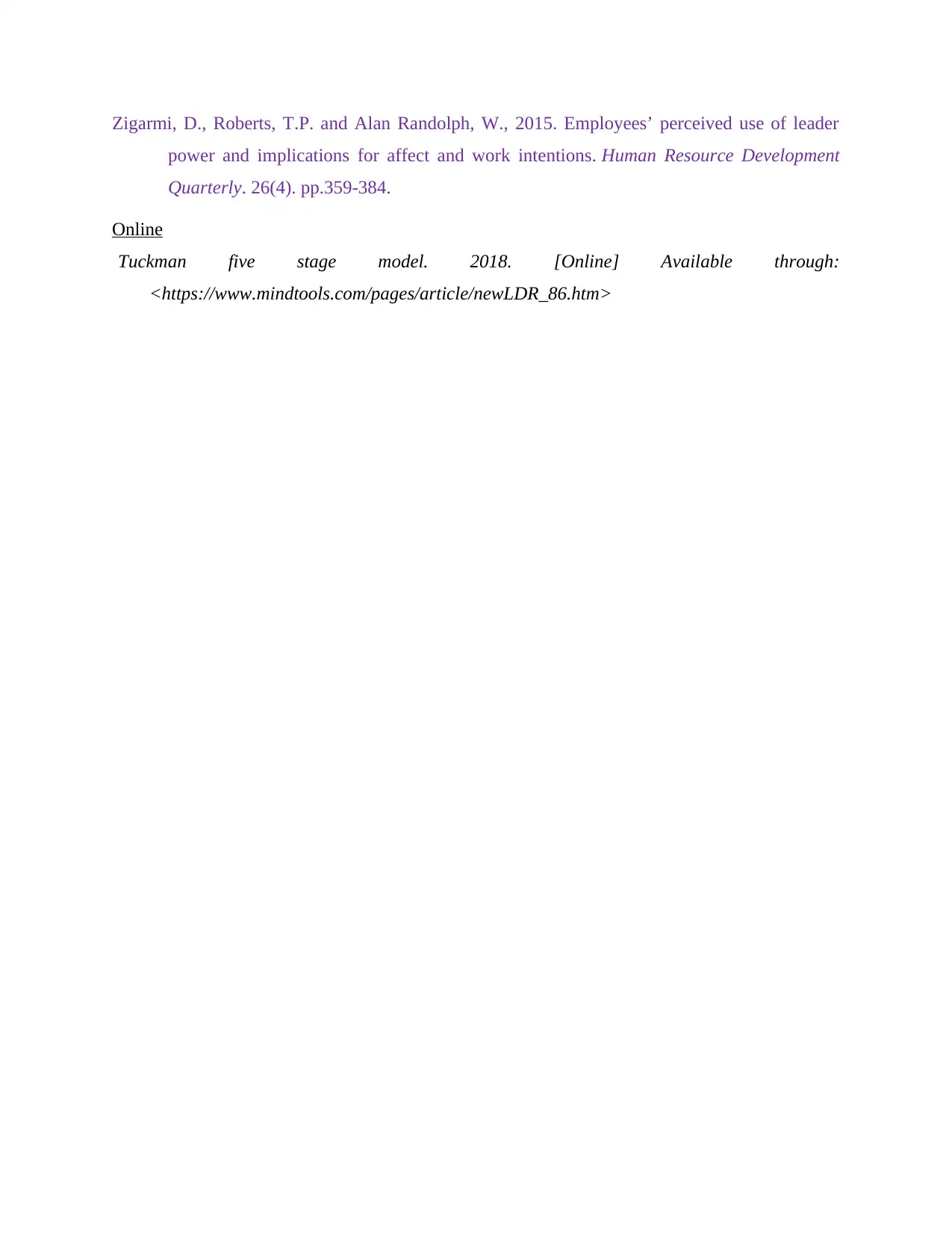
Zigarmi, D., Roberts, T.P. and Alan Randolph, W., 2015. Employees’ perceived use of leader
power and implications for affect and work intentions. Human Resource Development
Quarterly. 26(4). pp.359-384.
Online
Tuckman five stage model. 2018. [Online] Available through:
<https://www.mindtools.com/pages/article/newLDR_86.htm>
power and implications for affect and work intentions. Human Resource Development
Quarterly. 26(4). pp.359-384.
Online
Tuckman five stage model. 2018. [Online] Available through:
<https://www.mindtools.com/pages/article/newLDR_86.htm>
1 out of 10
Related Documents
Your All-in-One AI-Powered Toolkit for Academic Success.
+13062052269
info@desklib.com
Available 24*7 on WhatsApp / Email
![[object Object]](/_next/static/media/star-bottom.7253800d.svg)
Unlock your academic potential
Copyright © 2020–2025 A2Z Services. All Rights Reserved. Developed and managed by ZUCOL.




